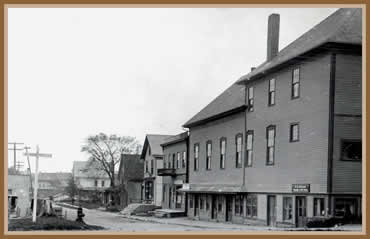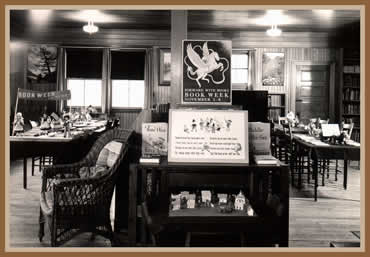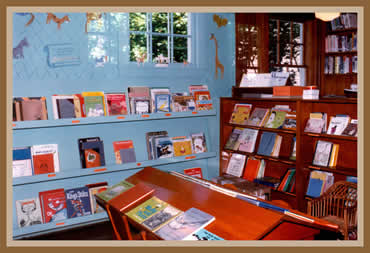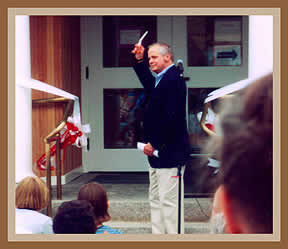The Southwest Harbor Public Library was built in 1895, although its history goes back to 1884, the year Mrs. Annie Sawyer Downs gathered some discarded books from the summer hotels and placed them on a shelf in a corner of Dr. R. J. Lemont’s drug store, which was located on Clark Point Road.
Dr. Lemont’s shop was the third building from the corner on Clark Point Road.
By 1886, the book collection had grown substantially and was moved to a former coffin shop that sat across the street from what is now Harbor House. This ex-coffin shop/ library building was later moved to site of the “Lawton Block,” currently Sawyers Market on Main Street.
Main Street looking where Sawyer’s Market is now. Number 5556 from the W.H. Ballard Collection of the Southwest Harbor Public Library.
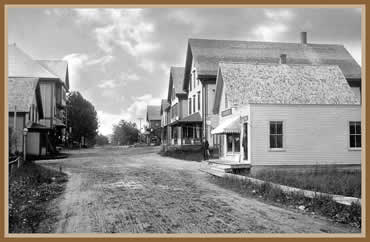
Then on March 17, 1888 the Tremont Public Library Association was formed for the purpose of looking after the books and raising funds for a permanent building. The Association’s name was changed to the “Southwest Harbor Public Library.”
In 1893 the Library Association bought the lot of land where the library building now stands for $100. Part of the money was raised through “Dollar Socials.” That is, the women in town volunteered to earn a dollar each, in some unusual way, and then they all met to hear their efforts celebrated in rhyme.
By May of 1895 when the library/ coffin shop was sold to John C. Ralph, the Association had already raised some money for a library building and it was voted to borrow more and build at once, as “there was no available place for the books, which could be secured.”
The Library in 1898. Photograph by George A. Neal – Number 6100 from the collection of the Southwest Harbor Public Library.
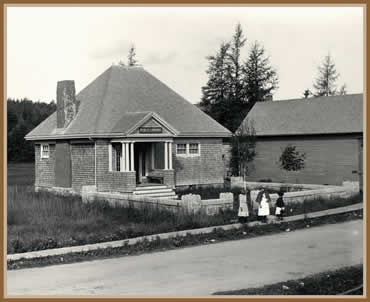
The library building was designed by Professor Eleazer Bartlett Homer in 1895, architect and Southwest Harbor summer resident.
Melvin Norwood was low bidder and got the contract for $898. The original building consisted of the area under the cypress-paneled hip roof, which forms the main reading room today. The stone wall was built shortly afterward with a donation from Mr. Albert Mathews, a summer resident from New York.
In 1894 an early “Friends of the Library, called the “Owl Club”, was organized by Miss Nellie Carroll. (Nellie Carroll later became Mrs. Seth Thornton, author of the book, “Traditions and Records of Southwest Harbor and Somesville”, published in 1938. Much of the information about the early days of the library is taken from her book.)
The Owl Club contributed $115 to the building fund and Mrs. Nathan Clark and Mrs. Arvilla Clark bought the library furnishings with the money raised. Both women were interested in the library and served as officers until their deaths.
The completed building was dedicated on October 31, 1895. According to the Bar Harbor Record of Wednesday, Nov. 6, 1895 “A large number of people from all parts of the town of Tremont gathered at Southwest Harbor Thursday evening to dedicate the library building… At 7:30 o’clock the library room was crowded.” Remember, the original library consisted of just what is now the Reading Room.
The Record article is fulsome and tells us a great deal about the dedication of the building and the philosophy of the people who made it all possible. Back in 1895, before automobiles, motion pictures and television, people expected both entertainment and solemnity on public occasions. At the library dedication participants first sang a hymn and listened to a prayer. Then a quartette gave a selection, plus an encore, a number of important people made some remarks, then a solo was sung and Miss Myra Powers delivered an essay entitled “Reading as an Art,” which held the most careful attention of the audience. according to the Record.
Afterward, Mr. George R. Fuller spoke a some length, saying that “it is a somewhat remarkable fact that not less than 350 individuals of the town of Tremont have contributed in some manner to the building of the beautiful book home we to-night assemble to dedicate.”
At the library dedication Mr. Fuller also talked about the influence of good books, e. g. the Bible, Pilgrim’s Progress and Uncle Tom’s Cabin AND “he urged the reading of such books as would make better men and women.” He also suggested that “every community should have as many volumes in the library as there are inhabitants in the town.”
After the presentation of the keys, the Bar Harbor Record notes that “the greater part of the assembly went to Tremont Hall”, which is the Masonic building at the corner of Main St. and Clark Point Road, “where a bountiful supper was served by the association…” About $20 was realized from the supper, which was expended for furnishings for the library.” Another successful library fundraiser!
The first magazine subscribed to by the Library was The Century and later, by the advice of Mr. Albert Mathews, Harper’s and The Atlantic Monthly were added to the list.
Mr. Mathews was very supportive of the library in its early years. Besides paying for the stone wall, he contributed books and generous checks. The secretary’s records of 1889 show that there were 480 books in the library, plus 42 volumes sent by Mr. Mathews.
Mr. Matthews’ gift, Gibbon’s DECLINE AND FALL OF THE ROMAN EMPIRE, in six volumes still sits on the shelf. Mr. Mathews’s name is on the title page of volume one with the notation Tremont 4/99 in pencil. It appears therefore, that he gave the library the set more than a hundred years ago in 1899. People back then, gave us solid tomes to “make us better men and women,” as Mr. Fuller had hoped. The first volume of Gibbon’s Decline and fall has been borrowed thirty times, but only six people made it all the way to volume six. Gibbon, however, is still available at the Southwest Harbor Public Library!
Many summer residents have supported the library over the years. The Village Improvement Society contributed money for the upkeep of the building and to buy books, and, Mrs. Thornton tells us, “the town appropriates annually a sum for its use.” In 1902, for example article #23 proposed, “to raise a sum not to exceed $25.” By 1916 $100 was asked for and by 1945 we were getting $2000 annually. When I became director in 1979, the appropriation was $12,000 and in 2005 it stands at $45,000 a year.
In fact, throughout most of the library’s history, the townspeople of Southwest Harbor, through taxation, have provided the bulk of the library’s financial support even though we are NOT a municipal library. And the town continues to give more money to the library each year than any other town on Mount Desert Island. I have always been very proud of Southwest Harbor residents for their century of support.
Librarians worked without pay until November 1888, when Miss Redlon was awarded fifty cents for each half days work. It was not until 1937, however, when Miss Ruth Eleanor Lawrence, a graduate of Drexel Institute’s library school in Philadelphia, was hired that the library became professionally organized and the book collection was catalogued. And I think it can safely be said that Ruth Lawrence is responsible for the library we have today. The volunteers she organized and the work they turned out was remarkable. Both the circulation and the number of books catalogued doubled during her tenure from 1937-1947.
The town was giving the library $300 a year in 1938, the year after Miss Lawrence arrived, and, when she left Southwest Harbor in 1947, the town’s appropriation had grown to $2000 annually, a respectable increase over a short period of time. She was a fine leader and an outstanding mentor to those of us who succeeded her.
Ruth Lawrence was also responsible for our first addition, built in 1939, which doubled the size of the library.
Children’s Book Week in 1941. Photograph by Willis H. Ballard – Number 5619 from the collection of the Southwest Harbor Public Library.
Ruth began our library’s celebration of Children’s Book Week and held special summer programs for the young people and children. Children’s Book Week is still held in November, but since we have so many children’s books and special events going on now, it may not bring the intense excitement to book loving children as it did then. Back in the 1940s and 50s, the children’s books were bought once a year for book week and during that week they were displayed in their bright new covers on tables in the children’s section of the library. We would be allowed to look at them all and each of us could sign up for one book to be borrowed at the conclusion of book week, which was on Saturday afternoon. Choosing the “one new book” was a big decision and I always hoped that the person who borrowed the new book I wanted to read next would be a fast reader.
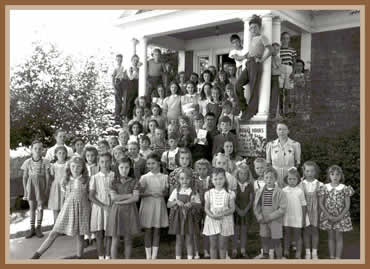
In 1947, when the trustees of the library said no to a second addition to the library, Miss Lawrence left us to work in the cataloging department of the Bates College library. And indeed it was 1955 before the library built its second addition. This was a room for the youngest children done in memory of Grace Simmons, who had rebound countless worn library books for the library.
The children’s room was financed by a bequest from Miss Simmons’ estate. It was at that time that we began the Southwest Harbor Public Library’s unique book shelving system for the little children, which allowed the picture books to face outward, their covers showing, AND they were shelved according to category, i.e. Dogs, Horses, Fairy Tales, Christmas, etc. Librarian Alma Hallenborg and I came up with this idea and I must confess that we were rather proud of it. In most libraries the picture books, which are often oversized, are shelved by author with only their narrow spines visible, making it very difficult for small children to find them.
Alma Hallenborg, who had been a friend of Ruth Lawrence, became librarian in 1948. She would leave in mid-May to operate her Mount Desert Bookstore in Bar Harbor, while a summer librarian filled in.
It may surprise you to know that back then, the job of summer librarian wasn’t considered very demanding. Miss Hallenborg would already have purchased, processed and catalogued the books she figured the summer people would want to read on their vacations. Natives, in those days, were too busy packing fish, cleaning cottages, etc. to read during the summer so the summer librarian’s job was mainly to keep the store open, smile at the patrons, stamp the due date on their books and collect the rental fees for puzzles and the new best sellers.
The library’s third addition was built in 1963 in memory of Seawall resident, Nate Salsbury. Mrs. Hitchcock was library director then. Frances was library director until November 1979, when I became director. I had worked as her assistant since the spring of 1959, and before that, while in high school, I’d worked for Miss Hallenborg shelving books and doing whatever else she would let me do. She and I would take inventory and discard books once a year, usually at the end of December when things were really quiet. Miss Hallenborg would sit with the shelf list in hand and I would stand before the shelves and physically inspect every book in the library for signs of wear and to check to see when it had last circulated.
During Frances Hitchcock’s tenure she and I encouraged patrons to use Maine’s interlibrary loan service as a way to improve OUR library service and satisfy a variety of tastes. Library budgets were really tight then and there was no way we could have, or even should have, bought every book requested. Usually we could get the requested book or information back to our patrons within a week and we did this by telephone and postcard.
The Southwest Harbor Public Library used interlibrary loan so extensively that we were able to provide service way beyond what you might expect for a small public library. Eventually, except perhaps for Northeast Harbor, we became the largest user of interlibrary loan at Bangor Public Library.
It was also during the 1950’s that the library’s used book sale began to grow and provide a significant amount of money to the annual budget.
The used book sale had had modest beginnings as a summer rummage sale, which raised $74.55 for the library back in 1938. As the years went by, gifts of books and library discards were added to the rummage until, in 1957, selling books brought in more money (323.89 to be exact) than the rummage did. It was decided to dispense with the rummage and just sell books.
Then, when trustee Polly Weaver began to run the sale, she held it outside on the lawn, which was fun when the weather cooperated. Later the sale was held in the library annex and, since the expansion of 2000, it has been held at the American Legion Hall, usually on the first weekend in August. The library’s used book sale has grown and grown and now requires year round work and preparation.
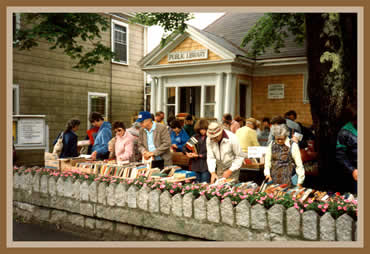
1984 Book Sale in the rain on Main Street.
During the winter of 1983-1984, while I was director and Caroline Allen was my assistant, we built a fourth addition to the library. During construction the library operated out of temporary quarters on Main St., formerly Pete Somes’ clothing store, now the Drydock restaurant.
This fourth addition to the library involved extensive interior remodeling of the existing structure, including skylights and restoration of our beautiful coffered ceiling, and was built from plans by architect Peter Forbes. The addition created more book stacks, a priority for me at that time, the floor to ceiling magazine rack, and a wonderful little office for the director, plus a workroom. The trustees raised $180,000 for this addition, all from private donations. We thought it was a lot of money at the time. Until, less than twenty years later, it became obvious we needed more room and we raised over a million dollars to create the magnificent public library we have today.
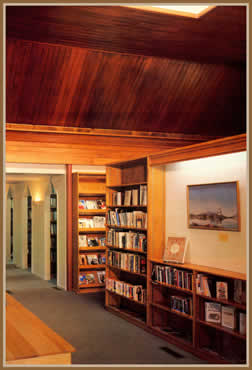
Looking from the Holmes Reading Room down the hall at the new stacks after the 1985 addition.
Since the completion of our latest library expansion in 2000, the library’s circulation has grown to over 66,000 annually. Thirty-three books per capita is one of the largest ratios in the state of Maine. We have computer stations for the public, wireless access, the library has numerous after hours programs and it is used extensively by various organizations, committees and community groups.
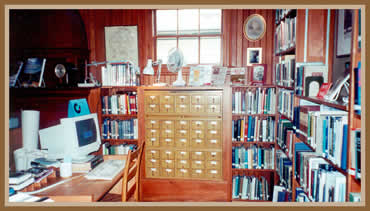
I realized, while preparing this talk, that it’s nearly twenty years now since I left the keys on the desk for Caroline Allen on December 31, 1985 and closed the back door of the library behind me. Free at last.
The achievements of the past twenty years tell me that it was not only the right time to leave, but that it was perfectly safe, for me to go. I left this library in good hands and so have all the directors who’ve come after me. May the good work continue.

